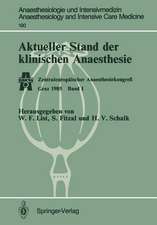Principles of Physiology for the Anaesthetist
Autor Peter Kam, Ian Poweren Limba Engleză Paperback – 21 sep 2020
| Toate formatele și edițiile | Preț | Express |
|---|---|---|
| Paperback (1) | 468.59 lei 3-5 săpt. | +51.01 lei 7-13 zile |
| CRC Press – 21 sep 2020 | 468.59 lei 3-5 săpt. | +51.01 lei 7-13 zile |
| Hardback (1) | 1078.60 lei 6-8 săpt. | |
| CRC Press – 21 sep 2020 | 1078.60 lei 6-8 săpt. |
Preț: 468.59 lei
Preț vechi: 493.26 lei
-5% Nou
89.66€ • 93.87$ • 74.19£
Carte disponibilă
Livrare economică 15-29 martie
Livrare express 01-07 martie pentru 61.00 lei
Specificații
ISBN-10: 0367202298
Pagini: 535
Ilustrații: 75 Tables, black and white; 383 Line drawings, color
Dimensiuni: 189 x 246 x 30 mm
Greutate: 1.26 kg
Ediția:4 ed
Editura: CRC Press
Colecția CRC Press
Locul publicării:Boca Raton, United States
Public țintă
Professional and Professional TrainingCuprins
Notă biografică
Peter Kam MBBS, MD, FRCA, FANCZA, FFARCSI, FHKCA (Hon)
Nuffield Professor of Anaesthetics, Sydney Medical School, University of Sydney
Royal Prince Alfred Hospital
Camperdown, Australia
Ian Power BSc (Hon), MD, FRCA, FFPMANZCA, FANZCA, FRCSEd, FRCP Edin, FFPFRCA
Emeritus Professor at the University of Edinburgh, Edinburgh, United Kingdom
Descriere
This book provides readers with an anaesthesia-focused alternative to general physiology textbooks. The new edition has been reorganised with the trainee anaesthesist in mind, into shorter bite-sized chapters ideal for exam revision. The content includes the physiology of all major organ systems, with specific emphasis on the nervous, respiratory, and cardiovascular systems as well as special sections on pain, aging, specific environments and obesity. Alongside the learning objectives, reflection points and a handy summary of physiological equations and tables, there is greater emphasis on clinical application in this fourth edition, with applied physiology included in almost every section.




























